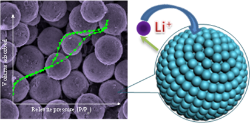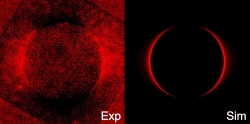
Futuristic Concept: The IAT Maglev, the New Doubledecker Magnetic Levitation Train
November 25, 2012
 Dieter Schramek and his Innovative Access Team (IAT) have further developed Germany‘s Transrapid system - the magnetic levitation train (or maglev) as it is normally called. They are now looking for partners and/or shareholders to make their revolutionary new traffic system a reality.
Dieter Schramek and his Innovative Access Team (IAT) have further developed Germany‘s Transrapid system - the magnetic levitation train (or maglev) as it is normally called. They are now looking for partners and/or shareholders to make their revolutionary new traffic system a reality.
Maglev trains have the potential to solve future transportation problems by providing a clean technology, high speed transportation (up to 400 km/h) at affordable prices. The new IAT-maglev saves space, time and energy due to its construction (double decker) and innovative energy supply system. Check out this interesting system at
http://www.iat-maglev.com/?q=Start
Monodisperse Magnetite and Maghemite Microspheres as Anode Materials for Lithium-Ion Batteries
November 23, 2012
Monodisperse Fe3O4 and γ- ned with precursor thermal transformation. The as-
ned with precursor thermal transformation. The as-
New Standard for Particle Size Distribution
October 11, 2012The American Society for Testing Materials, or ASTM, had published a new standard: E2834 - Standard Guide for Measurement of Particle Size Distribution of Nanomaterials in Suspension by Nanoparticle Tracking Analysis (NTA). The Standard is available from ASTM at http://www.astm.org/Standards/E2834.htm .
New Ferric Citrate-Binding Protein C Found in Bacteria
October 08, 2012
 A unique bacterial protein selectively binds an unstable triferric citrate complex to import iron into Bacillus cereus cells, reports a team from the University of California, Berkeley (Proc. Natl. Acad. Sci. USA, DOI: 10.1073/pnas.1210131109). Iron is an essential element that bacteria commonly sequester by sending ligands, called siderophores, to chelate insoluble Fe(III) in the environment. Selective binding and transport proteins then convey the complexes back into the cells.
A unique bacterial protein selectively binds an unstable triferric citrate complex to import iron into Bacillus cereus cells, reports a team from the University of California, Berkeley (Proc. Natl. Acad. Sci. USA, DOI: 10.1073/pnas.1210131109). Iron is an essential element that bacteria commonly sequester by sending ligands, called siderophores, to chelate insoluble Fe(III) in the environment. Selective binding and transport proteins then convey the complexes back into the cells.
Common siderophores include citrate and citratebased ligands. Citrate’s carboxyl and hydroxyl groups coordinate Fe(III). Previously, however, citrate-binding proteins were observed harboring only Fe(citrate)2 and Fe2(citrate)2. Kenneth N. Raymond and colleagues have now identified a B. cereus protein, christened ferric citrate-binding protein C, or FctC, that selectively binds Fe3(citrate)3 even when other iron-citrate species are present in solution. Only a few closely related species have genes for similar proteins, so FctC may give the B. cereus group an advantage by enabling import of iron complexes that other bacteria cannot sequester.
Report from the 12th German Ferrofluid Workshop
October 02, 2012The “12th German Ferrofluid Workshop” was held from Sept 26-28 in the Cloister Benediktbeuern close to Munich. More than 80 attendees presented 53 scientific contributions in 24 talks and a poster for each contribution. During the meeting the general assembly of the “Ferrofluid Society Germany”, which organizes this meeting and others, was held in a closed session. Because of the upcoming DFG Priority Program “Field controlled particle matrix interaction: synthesis, multi-scale modelling and application of magnetic hybrid-materials” the workshop was focused on these topics. Detailed information to the program and the abstracts of the workshop as well as for past workshops can be found here (in the frame “archive").
 The next workshop will be organized in combination with the kick-off meeting of the Priority Program in the week of Sept 24-28, 2013 in the Cloister Benediktbeuern again. More information and contact addresses concerning the Priority Program are listed on the pages of the German Research Council (DFG).
The next workshop will be organized in combination with the kick-off meeting of the Priority Program in the week of Sept 24-28, 2013 in the Cloister Benediktbeuern again. More information and contact addresses concerning the Priority Program are listed on the pages of the German Research Council (DFG).
Figure: Setup for experimental investigation of magnetically induced deformation of magnetic fluids presented by Jana Popp (Zimmermann group) from Technical University of Ilmenau.
Submitted by Silvio Dutz, Institute of Photonic Technology IPHT, Jena, Germany.
Combination Gd and USPIO MRI Contrast Agent
August 24, 2012Dr. Thomas Tourdias and colleagues recently published a study where they investigated if a combination of gadolinium-enhanced MRI (dotarem) followed by the injection of ultrasmall superparamagnetic iron oxide particles (USPIO) (sinerem) had advantages for the assessment of disease activity in multiple sclerosis phenotypes. Very interesting and well done study, in which they found that the combination of gadolinium and USPIO in patients with MS can help identify additional active lesions compared with the current standard, the gadolinium-only approach, even in progressive forms of MS. Lesions that enhance with both agents may exhibit a more aggressive evolution than those that enhance with only one contrast agent.
To look at the details, please click here.
Base sequences set shapes of gold-DNA nanoparticles
August 12, 2012
.bmp) DNA molecule control the shape and surface properties of gold-DNA nanoparticles. The findings could be used to create nanoparticles with shapes optimized for sensing, imaging, catalysis, and other applications.
DNA molecule control the shape and surface properties of gold-DNA nanoparticles. The findings could be used to create nanoparticles with shapes optimized for sensing, imaging, catalysis, and other applications.
Researchers often use DNA strands to help control morphology in nanoparticle synthesis, but the process has been by trial and error. Chemical biologist Yi Lu
of the University of Illinois, Urbana-Champaign, and coworkers, including Jinghong Li’s group at Tsinghua University, in Beijing, have discovered the method to this madness in preparing gold-DNA nanoparticles. By systematically varying DNA sequences added to solutions used to make gold-DNA nanoparticles, they found that like a genetic code, specific sequences lead
to distinct particle shapes and surface characteristics ( Angew. Chem. Int. Ed., DOI: 10.1002/anie.201203716 ).
Fluorescent Dye Maps Magnetic Field
July 29, 2012
 A fluorescent molecule that glows brighter in the presence of weak magnetic fields can enable an ordinary microscope to map the fields around magnetic nanoparticles (Nano Lett., DOI: 10.1021/nl202950h). Researchers hope that similar molecules could aid the development of nanostructures for data storage and quantum computing.
A fluorescent molecule that glows brighter in the presence of weak magnetic fields can enable an ordinary microscope to map the fields around magnetic nanoparticles (Nano Lett., DOI: 10.1021/nl202950h). Researchers hope that similar molecules could aid the development of nanostructures for data storage and quantum computing.
When materials scientists design new magnetic nanoparticles, such as those in memory chips, they have to collect detailed information about the strength and distribution of magnetic fields around them. To gather these data, the researchers rely on expensive equipment and complex setups. For example, liquid helium must cool the magnetometers used in superconducting quantum interference device (SQUID) microscopy. Adam E. Cohen, a chemist at Harvard University, and his colleagues envisioned a much simpler measurement based on the chemistry of an indicator molecule.
Normally, magnetic fields have little effect on the course of chemical reactions, says Cohen. When compared to heat energy, the energy from the interaction of a magnetic field and the spin of an electron is extremely small. But Cohen and his colleagues predicted that even very weak magnetic fields could strongly influence the emission of light by specific types of fluorescent molecules.
For more information, check out our Archives.
September 2017

Search this site with the power of

